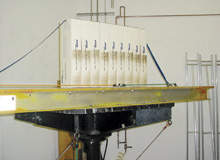
In layman's terms, vibration testing is the shaking of a product or package to determine its ability to survive in real world conditions. Technically, vibration refers to mechanical oscillations about an equilibrium point. The oscillations may be periodic such as the motion of a pendulum or random such as the movement of a tire over a highway or an aircraft on the runway at takeoff. In the testing world we deal with random vibrations; as in the movement of lading in trucks over the road
or in aircraft.
Vibration is present in all modes of transportation and all products are subjected to vibration during shipment, because it is not feasible to completely eliminate the sources of vibration. Consequently, it is necessary to design products and packaging to withstand those sources. The forcing frequencies of vibration are passed on by the wheels of the moving vehicle, the structure and drive train, and the suspension system.
These frequencies vary depending on continuing changes in surface condition, grade, joints in concrete and rails, and from other similar recurring discontinuities in road beds. Vibration affects individual components in a product, the product itself, the product combined with packaging and packages stacked together to form unitised loads.
Failure and assessment
Typical failure modes due to vibration include contact damage, breakage or abrasion to components, abrasion of sterile barrier systems and fatigue damage:
See Also:
Contact damage results when a component of the product yields enough to strike another component resulting in either breakage of the yielding component, breakage of the struck component or abrading or chipping of either component.
How well do you really know your competitors?
Access the most comprehensive Company Profiles on the market, powered by GlobalData. Save hours of research. Gain competitive edge.

Thank you!
Your download email will arrive shortly
Not ready to buy yet? Download a free sample
We are confident about the unique quality of our Company Profiles. However, we want you to make the most beneficial decision for your business, so we offer a free sample that you can download by submitting the below form
By GlobalDataCritical damage to the sterile barrier system results when packages constantly rub against one another inside the shelf box or shipping container and cause holes in the materials.
Fatigue damage occurs when the constant yielding such as bending of flexible materials, leads to cumulative damage over time.
The end result is the creation of pinholes in the material, causing a loss of sterile integrity. Vibration can also cause cosmetic damage to packages and products, rendering a product unacceptable and unsaleable. Most of the damage caused by vibration is not known to have occurred until the product is delivered and about to be used.
In the medical device industry, the use of vibration testing is critical because hidden damage from vibration can cause significant repercussions. At one extreme, if the product reaches its intended use with visible damage to the shipping container, the product may be rejected and returned to the manufacturer. Or if the sterile barrier system is picked from the shelf for a surgical procedure and has sustained visible damage, a new product will have to be retrieved, perhaps at a critical time in the surgery.
In a worst-case scenario, if the sterile barrier system is picked for a procedure but the damage is not readily visible and has a small pinhole due to fatigue or abrasion damage, the product may become non-sterile and put the patient at risk. So it is critical in the package development and design process to assess the ability of the sterile barrier system to resist the vibratory forces in the transport environment, ensuring that there is a very high probability that the product reaches its intended use in the condition for which it was designed.
Vibration's testing role
Package validation or package performance testing is based on the accepted fact that sterile medical device packages do not typically lose their sterility simply by being stored on a shelf.
Package failures are a result of environmental extremes and dynamic events which may have occurred during the manufacturing process, during shipping and handling to the sterilisation facility, or during distribution or transit to the point of end use. All of these processes may subject the finished
package to forces involving handling shocks, vibration, and high and low temperature and humidity extremes.
The GMP for Medical Devices Part 820.130 states that 'the device package and any shipping container for a device shall be designed and constructed to protect the device from alteration or damage during the customary conditions of processing, storage, handling, and distribution'. It is therefore generally accepted practice to perform simulated distribution testing in a laboratory setting to fulfill this requirement of the ISO 11607 standard. The vibration testing element of the
package performance assessment is a key component of the package evaluation process.
One ASTM method that deals with vibration testing of shipping containers states: 'Shipping containers are exposed to complex dynamic stresses when subjected to vibration present in all transportation vehicles. Approximating the actual damage, or lack of damage, experienced in shipping may require subjecting the container(s) and contents to vibration inputs'.
This can be very important for medical devices since they must be transported in the same environment that all products are distributed. Significant product and package interactions during shipment can be severe and may lead to package or product failure. Identification of critical frequencies and the nature of package stresses can aid in minimising the effect of these occurrences. Exposure to vibration can affect the shipping container, its interior packaging, means of closure and contents.
These tests allow analysis of the interaction of these components. Design modification to one or more of these components may achieve optimum performance in the shipping environment.
There are optional methods available to satisfy this segment of the package validation process. First, the package could be tested by simply shipping it to a destination using the anticipated mode. This method, although economical, does not lend itself to a high degree of control and repeatability, nor does it provide a statistically significant sampling of the product under evaluation.
Alternatively, laboratory simulations provide a means of subjecting packages to the anticipated distribution hazards of shock, vibration and dynamic compression in a controlled and repeatable manner. Observations of the package performance, as it is subjected to various hazards, can be accomplished in the laboratory and corrective action can be taken to alleviate any anticipated problems in a timely fashion.
Standard practice
Laboratory methods can be performed using standardised laboratory simulations such as ASTM D4169 'Performance Testing of Shipping Containers and Systems' or International Safe Transit (ISTA) procedures. The standardised laboratory procedures sequence a number of distribution 'elements' or dynamic tests that use realistic test intensity levels. The ASTM method also allows the user to design a test sequence which more closely matches a specific shipping environment. The most
commonly used standardised distribution simulation test for medical device package validation is ASTM D4169, Distribution Cycle #13. This method is designed for packages weighing less than 100lb and transported by air and motor freight (small parcel distribution system.).
A new method that has incorporated specific field data from the small parcel delivery system has been published by ASTM, entitled: ASTM D7386-08 'Standard Practice for Performance Testing of Packages for Single Parcel Delivery Systems'. This may have more realistic standardised simulation elements for the small parcel distribution environment. Early use of it in a laboratory setting has found it to be a robust test for medical device packages.
Recent changes in standards development activities have caused difficulties for medical device manufacturers in determining the best alternative for complying with package testing regulations. ISO 11607 requires that sterile medical device package systems be capable of withstanding the transportation and distribution environment. It recommends the use of the ASTM and ISTA standards for simulating the dynamic and environmental hazards associated with the distribution of products in the
laboratory.
A factor in considering which standard to use for compliance purposes is whether it is approved as a consensus standard, such as ASTM standards. This is important from the regulatory standpoint since the FDA reviews consensus standards and adds them to an approved list. They can be used to provide evidence of product efficacy, and compliance to vertical standards such as ISO 11607 in the case of package systems. ISTA transit testing standards are acceptable in complying with ISO 11607, even
though the standards are not contained in the list of FDA-approved standards.
ASTM D 4169-05 is currently an FDA-approved standard. The typical test regimen for medical device package testing is distribution cycle 13 (DC 13). This standard has been shown to be a robust but realistic distribution simulation test, due to its long history of use and package assessment success.
The new D 4169-08 distribution simulation standard has not been approved as of November 2008 but is pending. ASTM D 4169-08 will eventually be approved by the FDA. A couple of changes in the DC 13 test regimen were incorporated:
the bridge impact test has been added to the test sequence for long packages
the concentrated impact test has been added for shipping containers of 275# test and lower.
These changes do not pose a significant burden to medical device manufacturers to incorporate them into their testing regimen. The unit cost of performing the D 4169 test will be increased nominally to cover the minimal additional costs of performing these tests. These changes will not take effect until the FDA has approved the new revised standard. Some manufacturers have requested the ISTA 3A test standard for compliance to the ISO 11607. This is acceptable for compliance to the ISO
11607.
The test standard is more difficult and complex to perform and the test regimen is significantly more robust and severe for medical device packages than the D 4169 standard. Consequently, the cost to the manufacturer is higher and the possibility of the package failing the test is higher, resulting in potential redesign and retesting costs.
To complicate matters further, ASTM has approved and published a test standard similar to the ISTA 3A test standard – ASTM D 7386. The same cost and severity issues exist with this standard as with ISTA 3A.
Dealing with vibration
Vibration is a force in nature that is difficult to control and reduce. Packages and their contents will be exposed to these forces, which may be the cause of damage to products. It is important for the medical device manufacturer to assess the ability of the both the product and the packaged product to withstand these forces. In most package performance protocols, these vibration forces are incorporated into a regime of other transport hazards such as handling (shock), compression and environmental extremes. Often times these forces are cumulative and cause damage that might never occur with only one 'hazard' assessed.
There are several published simulation standards available for compliance to ISO 11607. The test engineer and package engineer should choose the best simulation test for the risk level they are willing to sustain. Vibration forces do cause damage to sterile barrier systems and are very often the hidden origin, so this hazard should definitely not be ignored.







